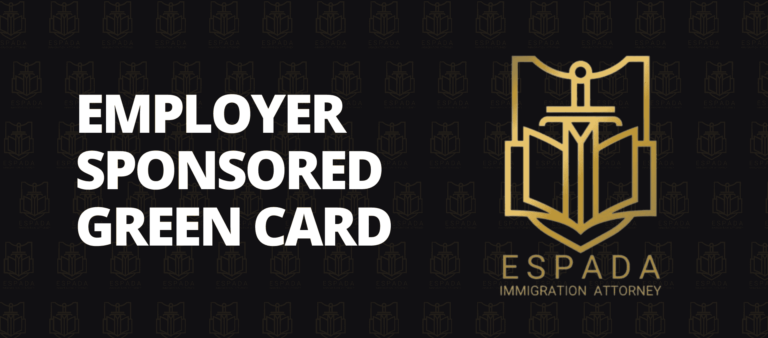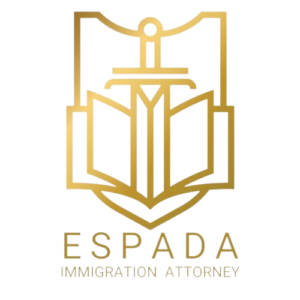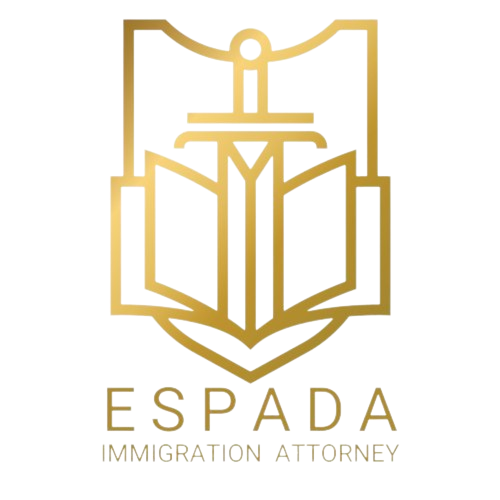Employer Sponsored Green Card: Step-by-Step Guide

As a professional, you may be eligible to obtain a green card through a job offer from a U.S.-based employer. This is often one of the most effective pathways to secure permanent residency in the United States. The process is relatively straightforward and can be completed efficiently. Additionally, unlike other immigration categories that initially provide a 2-year conditional green card, an employer-sponsored green card grants you a full 10-year green card upon approval.
This guide will cover everything you need to know about obtaining an employer-sponsored green card.
If you have any questions, feel free to email me directly at abbas@espadaimmigration.com. I am committed to helping you navigate this process effectively.
Overview:
- What is an Employer-Sponsored Green Card?
- What are the Benefits of an Employer-Sponsored Green Card?
- What is the Process of Getting an Employer-Sponsored Green Card?
- What are the Requirements to Get an Employer-Sponsored Green Card?
- What is the Processing Time to Get an Employer-Sponsored Green Card?
- What Documents are Needed to Get an Employer-Sponsored Green Card?
- Conclusion
1. What is an Employer-Sponsored Green Card?
The United States offers several pathways for foreign nationals to obtain permanent residency (a green card). Some options involve making a business investment, while others rely on family ties, such as marrying a U.S. citizen or having immediate relatives who are U.S. citizens. Another pathway is through employment, where a U.S. company sponsors your green card based on a job offer—this is known as an employer-sponsored green card.
In this process, a U.S. employer files specific immigration forms with the United States Citizenship and Immigration Services (USCIS) on your behalf. The employer acts as the petitioner (the entity submitting the application), and you are the beneficiary (the individual receiving the immigration benefits). By sponsoring your green card, your employer facilitates your legal pathway to permanent residency in the United States.
2. What are the Benefits of an Employer-Sponsored Green Card?
- Permission to live and work in the U.S.
- Green card eligibility for your dependents: Your spouse and unmarried children under 21 can also apply for green cards.
- Direct issuance of a 10-year green card: Avoids the 2-year “conditional” green card period.
- Lower qualification requirements: Standards are less stringent compared to the EB1A “extraordinary ability” and National Interest Waiver categories.
- No investment required.
- Path to U.S. citizenship: You can apply for naturalization after five years as a green card holder.
3. What is the Process of Getting an Employer-Sponsored Green Card?
Securing an employer-sponsored green card involves three main steps:
- Labor Certification (PERM): Your employer must obtain certification from the U.S. Department of Labor (DOL).
- Immigrant Petition: Your employer files Form I-140 with USCIS on your behalf.
- Status Adjustment or Immigrant Visa: You either adjust your status in the U.S. (Form I-485) or apply for an immigrant visa abroad (Form DS-260).
Labor Certification (PERM)
The first step is obtaining an approved labor certification from the DOL, commonly known as PERM. This certification ensures that hiring a foreign worker won’t negatively impact U.S. workers’ wages or job opportunities. To achieve this:
- Your employer must test the labor market to verify a lack of qualified U.S. workers for the role.
- Job advertisements must be placed, and all U.S. applicants must be fairly evaluated.
- A prevailing wage determination must be obtained by filing Form ETA 9141 with the National Prevailing Wage Center.
- Your employer must then submit Form ETA 9089 (Application for Permanent Labor Certification) to the DOL.
Immigrant Petition
After receiving an approved labor certification, the next step is for your employer to file an immigrant visa petition (Form I-140) with USCIS. Employer-sponsored green cards typically fall under two categories:
- EB-2 (Advanced Degree Professionals): For roles requiring a degree higher than a bachelor’s, such as a master’s or doctorate.
- EB-3 (Skilled, Professional, or Unskilled Workers):
- Professional workers: Require at least a bachelor’s degree.
- Skilled workers: Require a minimum of two years of experience or training.
- Unskilled workers: Require less than two years of training or experience.
Your employer submits Form I-140 along with supporting documentation to USCIS.
Adjustment of Status or Immigrant Visa Processing
Once USCIS approves the immigrant petition, you proceed to either adjust your status in the U.S. or apply for an immigrant visa abroad.
-
Adjustment of Status (Form I-485):
- Converts your current status to permanent residency.
- Requires you to be physically present in the U.S.
- In many cases, Form I-485 can be filed simultaneously with Form I-140 to expedite processing.
-
Immigrant Visa Processing (Form DS-260):
- Conducted at a U.S. consulate or embassy in your home country if you are outside the U.S.
- Involves submitting Form DS-260 online and attending an in-person visa interview.
- Upon approval, an immigrant visa is issued, typically within a week.
For further assistance or inquiries about the employer-sponsored green card process, feel free to reach out at abbas@espadaimmigration.com.
4. Requirements for Obtaining an Employer-Sponsored Green Card
Employer Requirements
1. U.S.-Based Employer
- The employer must be established in the United States.
- The offered position must be located within the United States.
2. Permanent, Full-Time Position
- The job must be a permanent, full-time role.
- Full-time employment is defined as working at least 35 hours per week.
- Permanent positions are those intended to last indefinitely, as temporary roles are not eligible.
3. Bona Fide Job Opportunity
- The role must represent a genuine job opportunity.
- The Department of Labor (DOL) evaluates whether the position is legitimate and not solely created to facilitate immigration for a foreign national.
4. Employer Attestations
- Employers must provide attestations under penalty of perjury on the labor certification application.
- These attestations include:
- The position is permanent and full-time.
- The job does not involve unlawful discrimination.
- The position is open to qualified U.S. workers.
- The employer will pay the prevailing wage for the role.
- The employer has adequate resources to compensate the employee at the prevailing wage.
5. Good Faith Recruitment Efforts
- Employers must demonstrate genuine efforts to hire qualified U.S. workers.
- Recruitment activities include:
- Posting a job order with the appropriate State Workforce Agency (SWA) for 30 days.
- Publishing two Sunday advertisements in a widely circulated newspaper.
6. Job Requirements
- Job specifications must not be tailored to the foreign national’s qualifications.
- They must align with customary industry standards and avoid undue restrictions.
7. Prevailing Wage Compliance
- The prevailing wage requirement safeguards the wages and conditions of U.S. workers.
- Employers must obtain a prevailing wage determination by filing Form ETA 9141 with the National Prevailing Wage Center (NPWC).
- The offered wage must meet or exceed the prevailing wage for the role.
8. Ability to Pay the Prevailing Wage
- Employers must demonstrate the financial capability to pay the prevailing wage.
- Proof may include:
- Recent tax returns showing net income meeting or exceeding the offered salary.
- Tax returns indicating net current assets at or above the salary offered.
- Pay stubs and W-2 forms confirming the beneficiary’s salary meets the prevailing wage.
Employee Requirements
1. Job Qualification
- The beneficiary must meet the education and experience criteria for the EB-2 or EB-3 visa categories and the job itself.
- EB-2 Category: Requires an advanced degree.
- EB-3 Category: Requires one of the following:
- A U.S. bachelor’s degree.
- At least two years of experience or training in the field.
- Less than two years of experience or training for entry-level roles.
2. No Grounds for Inadmissibility
- The beneficiary must not be inadmissible under U.S. immigration laws, which list 10 inadmissibility grounds, including health issues and criminal history.
3. Good-Faith Intent to Work for the Employer
- The employee must genuinely intend to work for the sponsoring employer after receiving the green card. While there is no minimum tenure required, the intent must be in good faith.
5. Processing Time for an Employer-Sponsored Green Card
The process involves three key stages:
1. Labor Certification Approval
- After filing Form ETA 9089 with the Department of Labor, processing generally takes 2–3 months.
- If the application is audited, processing may extend to approximately 7 months.
2. Immigrant Petition
- Employers file Form I-140 with USCIS, which typically takes 5–8 months.
- Premium Processing Option: Expedites the process but may take longer if a Request for Evidence (RFE) is issued, potentially adding 3–6 months.
3. Adjustment of Status or Immigrant Visa Processing
- Adjustment of Status: 6–8 months.
- Immigrant Visa Processing: 5–7 months.
Important Considerations
- Visa Availability: A visa number must be available to proceed. While most countries currently have visa numbers available for EB-2 and EB-3 categories, backlogs exist for China, India, and the Philippines.
- Visa Bulletin Updates: Check the Visa Bulletin to confirm visa availability.
- Concurrent Filing: Eligible applicants may file the immigrant petition and adjustment of status applications simultaneously, saving processing time.
- Work Authorization and Travel Documents: Applicants typically receive employment authorization (EAD) and travel permits within 3–4 months of filing the adjustment of status application.
For additional guidance, please contact us at abbas@espadaimmigration.com.
6. What Documents Are Required for an Employer-Sponsored Green Card?
Below is a general list of documents typically needed during the process of obtaining an employer-sponsored green card:
- Beneficiary’s CV or Resume
- Copies of the Beneficiary’s Diplomas, Degrees, and Transcripts
- Letters Confirming the Beneficiary’s Work Experience
- Beneficiary’s Birth Certificate
- Copy of the Biographic Page of the Beneficiary’s Passport
- Marriage Certificate of the Beneficiary (if applicable)
- US Employer’s Tax Returns
- Copies of Newspaper Advertisements Published for the Job Opportunity
- Detailed Job Description for the US Position
7. Conclusion
Obtaining a US green card as a foreign national can be achieved through various pathways, with an employer-sponsored green card being one of the most efficient options for qualified candidates. For suitable applicants, the process can be relatively straightforward and expedited.
If you have questions about the information provided or are interested in working with my firm to handle your employer-sponsored green card process, feel free to reach out to me directly at abbas@espadaimmigration.com. My team and I are responsive and ready to assist you.
Resources
- Business Immigration Law and Practice – Second Edition – Volume 2: Immigration Concepts, Chapter Two: The Labor Certification Application
- 20 CFR Section 656.10
- USCIS Employment-Based Immigration: Second Preference (EB-2)
- USCIS Employment-Based Immigration: Third Preference (EB-3)
- The Visa Bulletin
- Green Card Through Employer Sponsorship Application
Why Choose Us
Choosing the right immigration lawyer can make all the difference in achieving your U.S. immigration goals. At Espada Immigration Lawyer, we are dedicated to providing exceptional legal guidance and personalized support through every step of the process. Our team combines specialized expertise, transparency, and an unwavering commitment to client success, making us a trusted partner for all your immigration needs.
- Specialized Expertise
- Personalized Approach
- Transparent Guidance
- Client-Centered Commitment

DISCLAIMER: This article is provided for general informational purposes only and does not constitute legal advice. The information herein should not be interpreted as formal legal counsel nor does it establish an attorney-client relationship. This article is neither intended as a solicitation for legal services nor as a substitute for individual legal advice. For specific legal guidance, please consult an attorney in your jurisdiction. Actions based on information in this article are taken at your own risk, and I disclaim any liability for such actions. Please note that information may have changed since publication and may no longer be current. This article does not offer guarantees, warranties, or predictions regarding the outcome of any legal matters. Each case is unique, and results will depend on individual facts and legal issues. Thank you.
ATTORNEY ADVERTISING: Any invitation to contact our law firm on this website and related pages constitutes attorney advertising.
